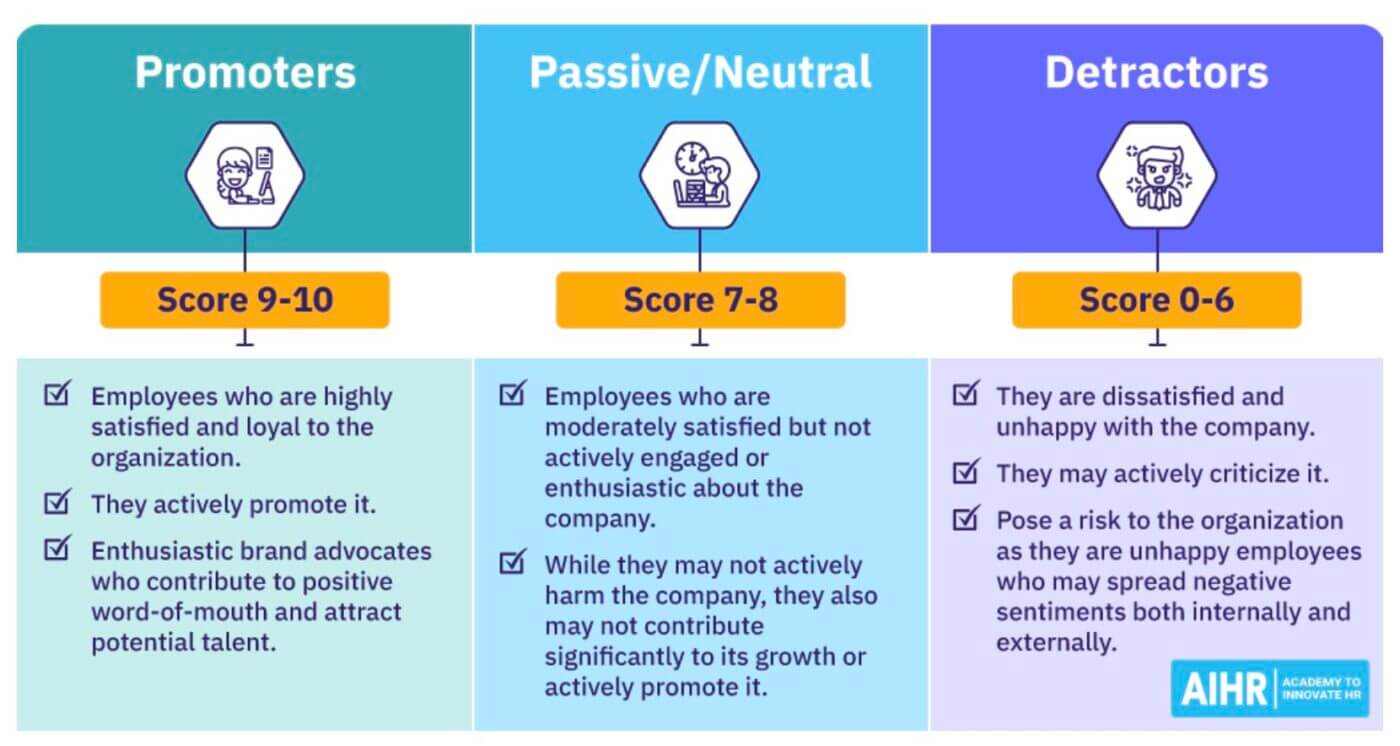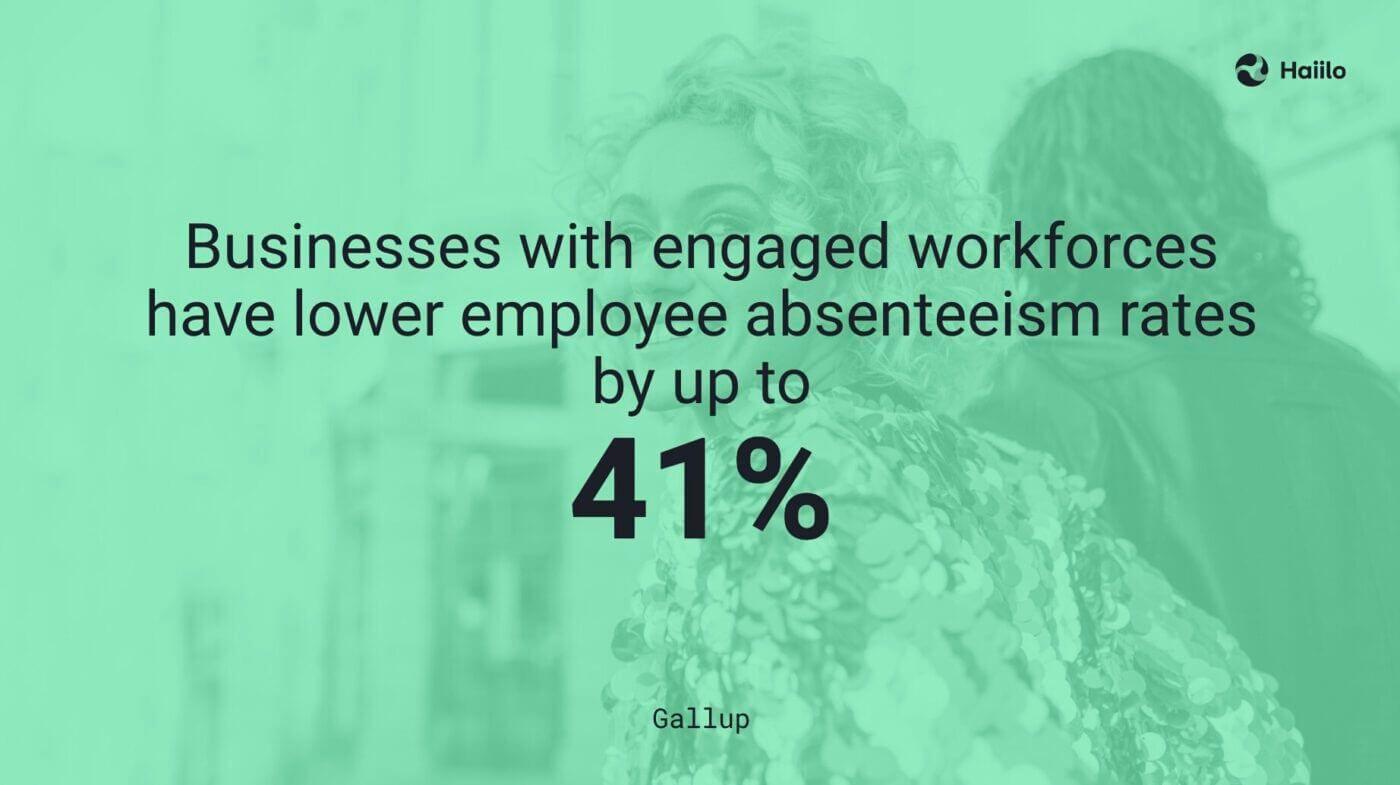Many employers are still not sure which employee engagement KPIs to track and how to measure the overall employee engagement in their organizations.
According to the Gallup report, 51% of employees are disengaged in the workplace, while 13% are actively disengaged. Another study on employee engagement found that companies in the United States lose between $450-$550 billion each year due to disengaged workers.

Since the consequences of low employee engagement can be devastating for organizations, it is critical that organizations track engagement and adopt new workplace initiatives to improve it.
In this blog, will define employee engagement KPIs and share some of the best metrics that can help you understand the level of employee engagement in your organization.
What Are Employee Engagement KPIs and Why You Should Track Them
Employee engagement KPIs are metrics that measure the level of employee engagement in the workplace.
They help organizations understand the current state of employee engagement in the organization and find opportunities for improvement. By regularly measuring employee engagement, employers can predict turnover, find ways to improve employee productivity, or discover opportunities for improving the overall employer brand.
There are many different ways to measure employee engagement, and we will cover some of the most popular KPIs later in this blog.
Overall, employee engagement KPIs measure different employee experience factors that directly or indirectly impact how engaged employees are.
Because every employee has different needs, expectations, and preferences, there is no single best way to measure employee engagement. But there are certain factors most of the employees care about:
- Compensation and benefits
- Growth opportunities
- Diversity, equity, and inclusion
- Workplace trust and transparency
- Employee feedback and recognition
- Manager and peer relationships
Modern intranet solutions can help you measure employee engagement!
Top 10 Employee Engagement KPIs to Track
There are dozens of various employee engagement KPIs, and most organizations rely on a combination of multiple different metrics.
Below, we will list the KPIs we find the most useful to track.
💡 Before we get started, take a look at our comprehensive employee experience guide, and don’t miss our Masterclass: Strategies for Driving Employee Engagement in the Workplace
1. Employee net promotor score (eNPS)
Employer Net Promoter Score, or eNPS, is a scoring system designed to help employers measure employee satisfaction and loyalty within their organization.
Similar to NPS, the eNPS system consists of a question asking employees to rate, on a scale from zero to ten, how likely they are to recommend the organization as a place to work.
The scores are rated into three categories:
- Promoters
- Passives (also called “neutrals”)
- Detractors
The overall eNPS score is calculated by subtracting the percentage of detractors from that of promoters. The result can range from -100% to +100%, highlighting the levels of engagement in your company.
Here is a great explanation for each of the categories by AIHR.

2. Turnover rate
Employee turnover rate is a measure of how many employees leave a company in a given period, usually a year. It’s calculated by dividing the number of employees who left by the average number of employees, then multiplying by 100.
Generally, the lower engagement, the higher employee turnover. Disengagement is usually the consequence of low job satisfaction, which ultimately leads employees to look for jobs elsewhere.
More specifically, companies that engage employees actively have an 18% lower employee turnover.
3. Employee lifetime value
Employee lifetime value is a metric that measures the total expected value of the contributions an employee will make to an organization over the lifetime of their employment.
As nicely explained in a Forbes article,
“Put simply, ELTV is the total net income that a company can expect from an employee during the period of their employment and is a useful mechanism to understand how valuable an employee really is.”
When employee lifetime value is low, then engagement is most likely low as well.
4. Absenteeism rate
This is one of the easiest to track and most trusted employee engagement KPI.
When employees are not engaged at work, they often try to spend less time there. This adds up to higher levels of absenteeism.
According to a Gallup Workplace report, businesses with engaged workforces have lower employee absenteeism rates by up to 41%.

On the other hand, engaged employees are “less likely to be sick.” Those who see their job as worthwhile or exciting are more likely to be fully involved in and enthusiastic about what they do.
5. Performance evaluation
Highly engaged people tend to perform better, making them more willing to participate in performance management reviews that lead to higher engagement.
Research by Gallup shows that employees who are consistently engaged have a greater commitment to quality.
Hence, performance evaluations are usually a great representation of the level of employee engagement.
When performance review results are poor, managers should put extra effort into understanding the reason behind it and how to bring the level of motivation and engagement to a satisfactory level.
6. Peer recognition
Engaged employees are more likely to engage in social recognition, and are more willing to give kudos and appreciation to their colleagues.
If employees rarely participate in your employee recognition program, that is probably a sign of low engagement.
Also, if your employees are not happy with how often they are recognized for their work, the chances they are not engaged are higher. According to a survey by OnePoll, 65% of respondents said they would work harder if they felt like their contributions were noticed by management
7. Survey participation rate
Engaged employees are always more likely to participate in various company and team-wide initiatives, including surveys.
When survey participation rates are low, that’s a sign of low employee engagement.
However, because most employee surveys are anonymous, it may be hard to figure out which employees don’t participate.
8. Employee referral rate
82% of employers rated employee referrals above all other hiring sources for generating the best ROI.
So it is not surprising that most companies have employee referral programs in place.
Similar to any other workplace initiative, the engagement with employee referral programs will be low if the overall employee engagement is low.
When employees are happy with their jobs and employers, they care about bringing in good new hires. If they are disengaged, they will rarely make an effort to help you in your talent acquisition efforts.
9. Intranet usage and engagement
According to a Deloitte report, organizations that used social intranets saw a 20% boost in employee satisfaction and a matching 87% increase in staff retention. For this, and many other reasons, most large organizations today have intranet solutions in place.
However, intranet usage rates can also be a great tool to measure employee engagement KPIs.
Modern employee intranets can give you valuable insights into the level of engagement in your organization. If the overall intranet usage is low, that’s a sign that the overall engagement is also low.
10. Advocacy
There is a strong correlation between employee engagement and employee advocacy. Meaning, the more engaged employees are, the more likely they will act as your brand ambassadors.
If you already have an employee advocacy program in your organization, you are probably measuring your employees’ engagement with it.
When engagement is low, this can be a sign of the overall low employee engagement in the organization.
Best Way to Measure Employee Engagement
According to a Gartner poll, only 16% of companies leverage technology to track employee progress and engagement.
Even though many HR tech providers claim to measure people-related KPIs, the best way to measure employee engagement and employee experience is by regularly distributing employee surveys.
Most large organizations today have some kind of company survey in place, but many of them don’t act on results, leading to even lower engagement.
But why is that?
Mostly because employers are unsure about how to analyze the data, draw valuable insights from it, and understand which new improvement initiatives to introduce.
Luckily, advanced survey solutions such as Haiilo come with built-in mechanisms that don’t only collect and analyze data but provide actionable recommendations for improvement.
With automated analytics, you easily anticipate problems and identify the best practices to support and engage your teams. Furthermore, custom notifications allow you to act on specific issues before they turn into turnover, absenteeism, or disengagement.
Furthermore, the solution uses AI for survey creation which elevates the process of gathering valuable feedback, enabling communicators and HR professionals to design effective survey questions with the help of generative AI.










